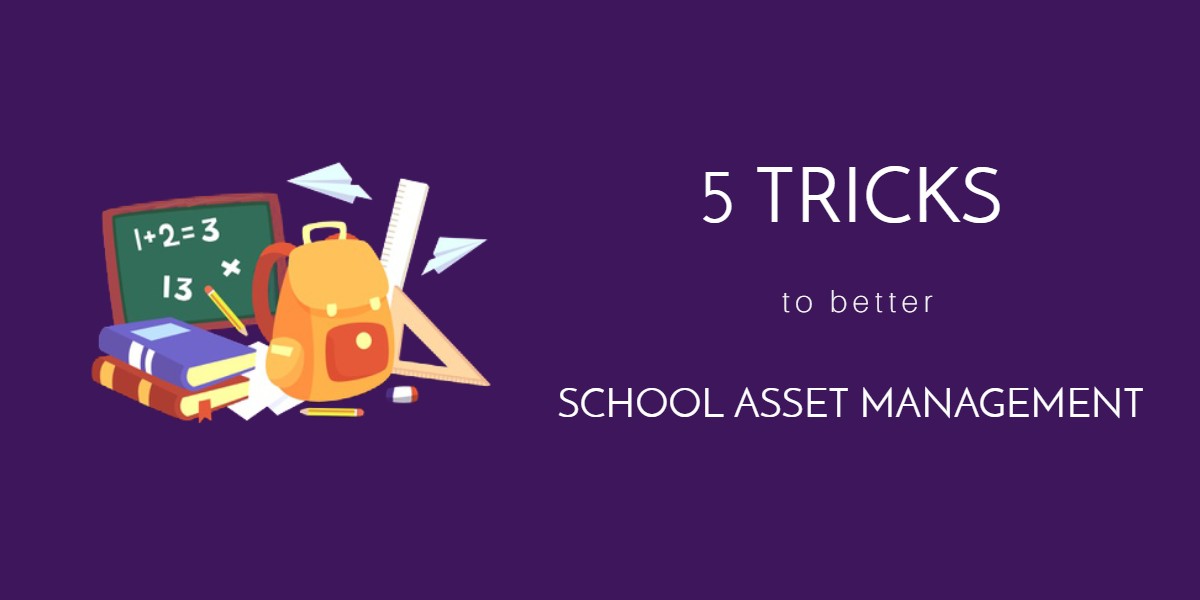Education is a trillion-dollar industry and it is flourishing now more than ever. With student numbers growing sharply, there’s a need for adequate school resources to ensure quality teaching. This is why school districts need to track myriads of inventory and digital assets, not only across campuses but also across individual students.
These trends can be attributed to an economic shift towards more knowledge-intensive professions. In 2015, around 50.1 million students attended the American public K-12s alone. Many more students were enrolled in colleges and universities across the globe.
Add to this, blended learning and one-to-one computing methods have diversified the asset base of educational institutes. Education assets now include loaner IT devices too.

All this growth calls for increased spending from already stretched school funds. This means schools must re-evaluate their management policies.
To do this, they need to shift from old-school asset management practices to automated asset management solutions.
Challenges with traditional school asset management
Despite this rapid growth, most educational institutes still rely on good old pen and paper or spreadsheets to record and track asset movements.
In an era where online learning is taking over traditional classroom learning, the use of manual school asset management techniques just doesn’t make sense.
Traditional asset management methods may bleed into many administrative challenges for schools. Here are some of the most basic ones.
1. Disrupted classroom operations
Think about it: Each campus has around 50 classrooms and each classroom has 30 students. The 1:1 method, therefore, requires you to track around 150 loaner devices across campus. Let alone the various teaching aids, projectors, and furniture items associated with a class.
With many lessons scheduled at a certain time, it is hard to keep tabs on such a diverse asset base across different classrooms. This becomes increasingly difficult for schools that use spreadsheets, the mainstay of old school asset management systems.
Even worse, when the asset count keeps multiplying. Sifting through such a clunky log is time-consuming and simply put, agitating.
You may not be able to deliver the right assets in the right classroom before the lecture begins. This can disrupt your classroom activities, eventually leading to inefficient school administration and poorer student performance.
2. Inefficient allocation of funding
According to the US Census Bureau, 29 states have reduced their public funding to K-12 schools over the last decade. With approximately 47% of American K-12s relying on state funds, this adversely affects their budget and forces them to scale back on educational spending.
Manual asset tracking systems make it hard to identify assets that break down frequently and do not add value to the school operations. Even if one tries, it involves long complex calculations to arrive at the book value of many assets. Hence, schools often end up overstocking items they don’t even need.
Apart from this, a lack of real-time visibility into school assets means they are prone to getting lost or misplaced. This makes disbursement of funds a game of shifting priorities.
School administration often spends most of these tight funds trying to replace lost assets or getting equipment repairs done. Improper use of funds may result in disgruntled stakeholders and halt the funding supply.
3. Inaccurate asset records

There is a high risk of information accuracy with paper logs and spreadsheets. Since you’re manually recording data on the whereabouts and status of each asset, you aren’t really aware of the real-time scenario in most cases.
There may be instances of ghost assets – assets that appear in your records but have actually been lost.
Here’s what Shannon Newman, an IT Assistant Manager at Southern Illinois University Carbondale says of them:
“When assets move, they end up lost because that info cannot be updated by the people that move it.”
The presence of ghost assets due to inaccurate records can force a school to pay more on its taxes and insurance expenses. This further saps the school administration of its budget.
Since most of these challenges arise from a lack of effective school asset management, it is key for schools to implement a dedicated asset management strategy so they can focus on improved education delivery to students.
Here’s how to go about it!
Automate your school asset management methods
Automating school asset management helps eradicate all the manual inefficiencies.
You can create a centralized cloud database to host all the data regarding your assets. This will enable you to extract relevant asset information, anytime and from anywhere you want. There’s no need to sift through clunky spreadsheets.
Save time and focus on more important tasks, like preparing your students for a global workspace.
Dedicated school asset management software is a turnkey solution to automating asset tracking. It has many features to streamline your asset management processes so you can focus on quality education delivery.
You can do the following with school asset management software in place:
1. Carry out faster asset checkouts for staff and students
School administration often needs to check out assets like loaner equipment or sports goods to students from various classes.
With school asset management software, design and print asset tags like barcode labels for such equipment. You can then scan these barcode labels and check assets out against student or staff usernames as needed. This allows you to track usage by a user trail and reduce instances of theft and misplacement.
Barcode scans fasten the checkout process. It’s only a matter of a few seconds! You no longer need to manually type in data or prepare intensive paper logs.
With easy check-ins and checkouts and a detailed user trail for each asset, school asset management solutions help you both enforce and monitor asset movements from a single server.
2. Ensure conflict-free reservations for seamless lectures
One of the major challenges educational institutes face today includes disrupted classroom activities. This bleeds from ineffective, manual asset management practices.
School asset management software combats this issue with an availability calendar. It shows a real-time view of which equipment is available, checked out or under maintenance across a specified duration.
This way, teachers can only reserve equipment that’s available for upcoming lectures. If a certain piece of equipment is unavailable for the class duration, you can get it arranged well before the lecture begins. This also prevents conflicting reservations of the same equipment for different lectures.
School asset management software also offers the option to reserve related assets together as a bundle. For instance, you can reserve art supplies for an art class in advance, without having to reserve each item individually. Doing so saves time, reduces conflicts and improves classroom efficiency.
3. Ensure data security with departmental access

Public school districts span over multiple campuses across counties. These campuses, in turn, have different departments such as Arts and Humanities, Natural Sciences and PE.
Asset management can get tricky for the administration when catering to the needs of several different departments. Asset information is being used at many user levels across departments. This makes data security and authorized asset use a major concern.
There may be instances where staff users may check out assets to themselves without getting permission from the authorized personnel.
School asset management software prevents this with access control. It limits asset data visibility by departments so each department only views data for items that it’s entitled to use.
You can also choose to set up arbitration settings. This enforces staff and students to request equipment checkouts from administrators. Such a measure ensures that assets are being used by the right people and for their intended purpose.
4. Improve asset performance through regular maintenance
Apart from conflicting reservations, unanticipated equipment breakdown can disrupt classroom operations too. Think, a projector stopped working midway a lecture. You can reduce instances of unplanned equipment downtime by getting regular preventive repairs done on your school assets.
School asset management software facilitates preventive maintenance. It gives you the ability to schedule service events for different equipment such as laptops, projectors, etc.
You can carry out the following actions with the services module of school asset management software.
- Create service tickets: Keep track of service events and details like maintenance costs, dates and associated vendors.
- Run recurring services: Automate regular service sessions for selected equipment to enforce preventive maintenance. This ensures that all items function at their best during lectures.
- Send maintenance alerts: Notify relevant departments about upcoming maintenance sessions in advance.
- Manage vendors: Keep detailed records of all vendors at a single place. This helps you to filter out reliable manufacturers of school equipment and procure from them only.
With a centralized database on the service history of all your assets, you can determine their total cost of ownership (TCO). Accurate knowledge of TCO helps you make smarter budget projections and apply for funds accordingly.
5. Maintain funding compliance with more transparent asset data
Since most public schools rely on external funding, an important question that arises is “Can you verify if the funds are being spent properly?”.
School asset management software enables you to track purchasing data such as purchase orders, purchase cost and depreciation of each asset you buy.
Most software solutions also give you the option to add custom data fields so you can record the funding source against each asset you buy. This is a key data field to record for schools as they are often restricted in terms of where they can spend their funding dollars.
For instance, you can only use funds acquired for the Sciences department to buy assets for the Science department.
Furthermore, you can use custom reports to furnish relevant data on the usage of funds to the concerned stakeholders. School asset management software offers more visibility into your fund disbursement practices so you can ensure funding compliance at all times.
School asset management software may save you millions of dollars

Most school districts are huge in terms of their operations. An instance of a single accounting error can cascade into major discrepancies and conflicts for them. This makes the use of error-prone spreadsheets only a fool’s game.
Familiar with the University of Toledo typo fiasco? A single Excel error caused them to believe that they had $2.4 million extra in their revenue. They included this in their proposed budget and had to face significant reductions in their state funding due to the reported error.
You can save millions in funding dollars and sidestep true-up costs if you have a dedicated asset management solution in place. Asset check-ins and checkouts via barcode scans eliminate the need for manual data input.
This reduces any possibility of accounting errors and ensures that your asset records represent a true picture of your school operations.
More transparent and accurate asset records help you win the trust of your sponsors and student community, and ensure continued funding. Don’t lug around the burden of outdated asset tracking methods anymore. Kick-start your next academic term with school asset management software!
Read more: How School Tracking Software Helps Manage Equipment Across School Districts
About EZOfficeInventory
EZOfficeInventory is the leading school asset management software. It enables you to track, maintain and report on equipment from anywhere, at any time. We offer a free 15-day trial – no credit card required!







